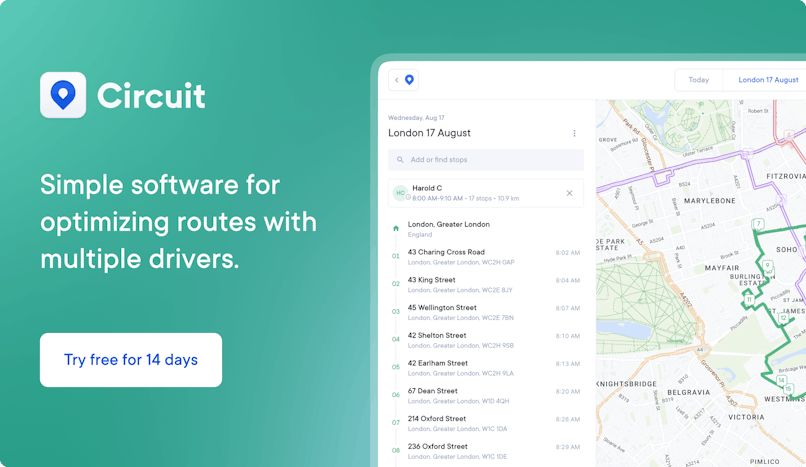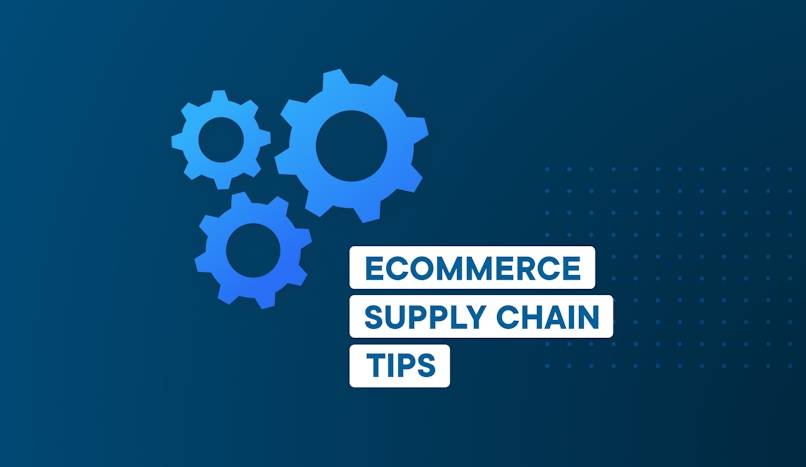eCommerce Supply Chain: Stages, Challenges and Management Tips
Learn about the key stages of the ecommerce supply chain and how you can optimize and streamline the process for your business.

Delivery is a key stage of the eCommerce supply chain. Streamline yours with Circuit for Teams.
Running a successful eCommerce business requires more than just quality products and a user-friendly website. It also hinges on a well-managed and efficient supply chain.
You’ll want to optimize every step in your eCommerce supply chain — from sourcing products to delivering customer orders — for seamless operations and an excellent customer experience.
However, this journey is not without its hurdles, and you’ll need to tackle these challenges head-on to thrive in the fiercely competitive online marketplace.
In this article, I’ll outline the key stages of the eCommerce supply chain, exploring the role of each one and the challenges that come with them.
I will also offer some practical eCommerce supply chain strategies to help you overcome these challenges and optimize your supply chain for success.
Retail eCommerce sales worldwide are expected to exceed $8 billion by 2026. So, whether you're a startup eCommerce business or an established omnichannel retailer, understanding and addressing the opportunities and challenges within the supply chain lifecycle will help you gain a competitive edge in this fast-growing market.
Key takeaways
- A streamlined eCommerce supply chain is the foundation of your eCommerce company, allowing you to meet demand and deliver products on time, ultimately increasing customer satisfaction.
- The eCommerce supply chain includes six stages: Determining supply and demand, warehousing, inventory tracking, order management, delivery, and reverse logistics.
- Regularly reviewing and optimizing your supply chain keeps it aligned with your business goals so you can adapt to changing market conditions.
- A proactive and technology-driven supply chain management approach should include auditing your current supply chain, implementing accurate tracking metrics, streamlining inbound operations, drawing up an efficient warehouse plan, and maintaining effective labor management.

eCommerce supply chain stages
In the world of online retail, the supply chain has several key stages.
Let’s explore each to understand its importance, highlight the challenges, and offer tips to manage them.
1. Determining supply and demand
During this stage, you should analyze market trends, customer behavior, and historical data to determine your products' expected supply and demand in order to make cost-effective buying decisions.
Accurately forecasting demand will help you avoid overstocking and stockouts, optimize your inventory levels, reduce costs, and deliver a seamless shopping experience for your customers.
Challenges may include fluctuating customer preferences and unpredictable market conditions.
To manage this stage effectively, you can leverage data analytics, conduct market research, and establish strong communication channels with your suppliers and customers.
2. Warehousing
Warehousing is a major aspect of eCommerce logistics that involves storing, organizing, and managing inventory effectively to deliver smooth order fulfillment for your eCommerce store.
Effective warehousing helps you maintain appropriate stock levels, streamline order processing, and improve customer satisfaction.
Challenges in warehousing include limited space, multiple warehouse and distribution center locations, and inventory accuracy issues.
To overcome these challenges, you can use an inventory management system or warehouse management system (WMS), optimize your warehouse layout, use more efficient picking and packing processes, or even consider co-warehousing.
3. Inventory tracking
Inventory tracking is an essential part of the supply chain where you monitor and manage the movement of products — activities like receiving, counting, labeling, and updating inventory records.
Accurate tracking is necessary to maintain inventory accuracy, prevent stockouts, and identify issues like theft or shrinkage.
Challenges in inventory tracking often come from human error, discrepancies between physical and system records, and a lack of real-time visibility.
You can track your inventory using barcode or radio-frequency identification (RFID) technology, stock-keeping units (SKUs), inventory management software, and by conducting regular cycle counts and audits.
4. Order management
Order management is the process of receiving, processing, and fulfilling customer orders (order entry, payment processing, order confirmation, and coordination with various teams involved in order fulfillment).
Efficient order management is essential for processing orders in a timely and accurate manner, reducing errors, and improving customer satisfaction. Challenges may include order complexity, volume fluctuations, and order fulfillment speed.
To streamline order management, you can automate order processing, integrate your order management systems for seamless data flow, and establish clear communication channels with logistics partners.

5. Delivery
The delivery stage plays a vital role in ensuring customer satisfaction and loyalty.
Efficient delivery management involves choosing the right shipping method, coordinating with carriers, and keeping track of the shipment until it reaches its final destination.
Challenges may include coordinating logistics, managing shipping costs, and tackling last-mile delivery issues.
To handle these challenges effectively, partner with reliable shipping providers and distributors, leverage real-time tracking technology, and optimize your delivery routes using a helpful tool like Circuit for Teams, which offers all these functions.
6. Reverse logistics
Reverse logistics involves handling the flow of products from your customers back to you for product returns, repairs, or exchanges. It includes activities such as return authorization, product inspection, refurbishment, or disposal.
Effective reverse logistics management is essential for maintaining customer satisfaction, minimizing losses, and efficiently managing your inventory.
Challenges may include complex and expensive return processes, product condition assessment, and managing customer expectations.
To handle reverse logistics efficiently, you can establish clear return policies and streamline your return processes so they’re super easy for you and your customers. This streamlining might include how you inspect and refurbish returned products, for example.
Key eCommerce supply chain challenges
Here are some of the issues you’ll likely run into with your eCommerce supply chain.
- Demand forecasting uncertainty: Predicting customer demand is tough due to fluctuating market trends, seasonality, and changing customer preferences. Getting it wrong can lead to overstocking or stockouts, resulting in lost sales, increased carrying costs, and unhappy customers.
- Inventory management complexity: Balancing stock levels, optimizing storage space, and maintaining accurate inventory records are all hard parts of inventory management. If you mess this up, you might end up with excess inventory, increased holding costs, and trouble fulfilling customer orders on time.
- Order fulfillment speed: Rapid order processing, picking, packing, and shipping are crucial for customer satisfaction. Order fulfillment delays can lead to bad customer reviews, a dip in customer loyalty, and lost sales.
- Last-mile delivery issues: Last-mile delivery challenges like traffic and wrong addresses can result in delivery delays, failed delivery attempts, and angry customers. They can also increase your transportation costs and slow down your supply chain.
- Product returns and reverse logistics: Handling product returns and managing reverse logistics can be complicated and pricey for eCommerce businesses. Mishandling your product returns can increase your costs and hurt customer satisfaction.
- Supply chain visibility: This means keeping tabs on everything that's happening in the supply chain, like where products are and how much is in stock, so you can make smart decisions and keep things running smoothly. Lack of visibility among multiple suppliers, warehouses, and shippers can make it hard to track your inventory, identify bottlenecks, and resolve supply chain disruptions fast enough.
- Integrating multiple systems and technologies: Incompatibility between your interlinking systems — such as inventory management, order management, and customer relationship management software — can cost you time and money by requiring manual workarounds, which can lead to errors. It can also impact your overall efficiency, data accuracy, and decision-making abilities.
- Supply chain collaboration: Sometimes, different stakeholders in the supply chain (including suppliers, third-party logistics partners, carriers, and fulfillment centers) don’t work well together thanks to miscommunications, lack of transparency, or conflicting priorities. This can disrupt the flow of goods and information, resulting in delayed shipments, poor service levels, and decreased customer satisfaction.
Overcoming supply chain challenges
You can address supply chain challenges like the ones I just discussed by staying ahead of market trends, getting customer feedback, and regularly evaluating and refining the processes in each of your supply chain stages.
Leveraging technology solutions such as inventory management systems, data analytics, and automation tools can also streamline these operations and simplify your decision-making.
Taking a proactive and technology-driven approach to managing your supply chain will help you achieve sustainable success in today’s competitive eCommerce landscape.

5 eCommerce supply chain tips
Here are five tips to optimize your eCommerce supply chain. These strategies can help you streamline operations, improve efficiency, and deliver an exceptional customer experience.
1. Audit and revise your current eCommerce supply chain
Thoroughly audit your existing supply chain processes so you can identify areas for improvement. Look for inefficiencies or cost-saving opportunities in stock replenishment, order delivery time, and raw materials sourcing, and consider outsourcing your fulfillment process.
By assessing your supply chain's strengths and weaknesses, you can fix processes to improve efficiency, overall performance, and your bottom line.
Regularly reviewing and optimizing your supply chain keeps it aligned with your business goals so you can adapt to changing market conditions.
2. Implement accurate tracking metrics
Accurate and up-to-date inventory tracking is another important part of effective eCommerce supply chain management.
By implementing strong tracking metrics, you can gain real-time data for your inventory levels, improve order accuracy, and avoid stockouts or overstocking.
Accurate tracking metrics also let you make data-driven decisions, streamline your operations, and enhance customer satisfaction thanks to timely order fulfillment.
3. Streamline inbound supply chain operations
Efficient inbound supply chain logistics can also contribute to a smooth, snag-free supply chain.
Streamlining procurement, transportation, and supplier management processes can reduce lead times, optimize inventory levels, and improve overall responsiveness.
By fostering solid relationships with suppliers, optimizing transportation routes, and implementing effective demand forecasting, you can minimize delays, reduce costs, and enhance overall supply chain performance.
4. Design the most efficient warehouse plan
An efficient warehouse layout and design can significantly impact your supply chain operations.
To optimize your warehouse operations, consider your product flow, storage capacity, and order fulfillment processes. A well-organized warehouse improves inventory management thanks to faster and more accurate order picking with fewer handling errors.
Putting efficient warehouse practices in place can enhance order fulfillment speed, reduce costs, and improve customer satisfaction.
5. Effectively manage labor
Properly managing your labor resources is important for optimizing your eCommerce supply chain.
Make sure you have an adequate workforce to handle demand fluctuations and meet customer expectations. Labor management strategies such as workforce planning, training programs, and performance tracking can help streamline your workforce.
By aligning your labor resources with demand, you can optimize productivity, reduce labor costs, and maintain the best service levels.
Your streamlined eCommerce supply chain
A well-managed eCommerce supply chain is the backbone of your online business, letting you meet customer demand, deliver products on time, enjoy cost savings, and get a competitive edge.
Whether it's accurate demand forecasting, efficient warehousing, effective inventory tracking, smooth order management, reliable delivery, or labor optimization, each part of the eCommerce supply chain needs careful attention and continuous improvement.
By taking proactive measures to address challenges and by following best practices, you can build a strong foundation for sustainable growth in the ever-evolving world of eCommerce.
Streamline your delivery stage with Circuit for Teams
A key part of any eCommerce supply chain is that last-mile delivery stage, where your customer finally gets their order. That’s where we come in.
Circuit for Teams helps you efficiently manage both small and large delivery driver teams, empowering dispatchers to make instant corrections or pin stop locations with just a tap.
We also understand the importance of visual clarity when managing multiple routes. That's why Circuit for Teams has an option for toggling between detailed and simplified stop markers on the map view, reducing clutter and giving you a clear view of individual stops and route progress.
Streamline your delivery operations today and unlock the full potential of your team with Circuit for Teams.




